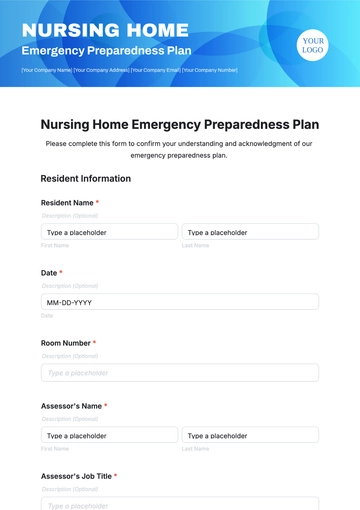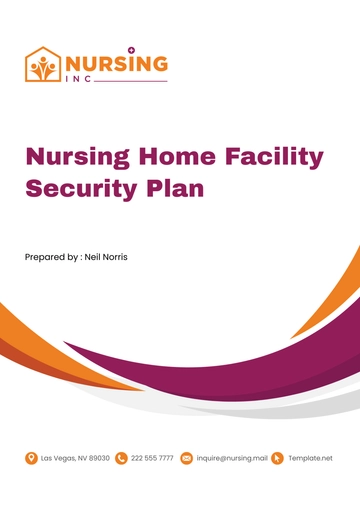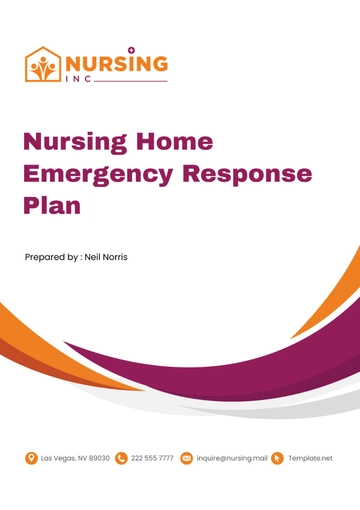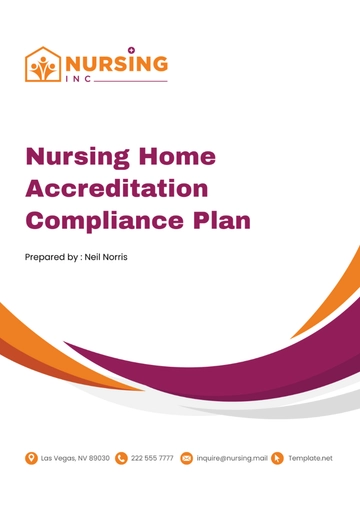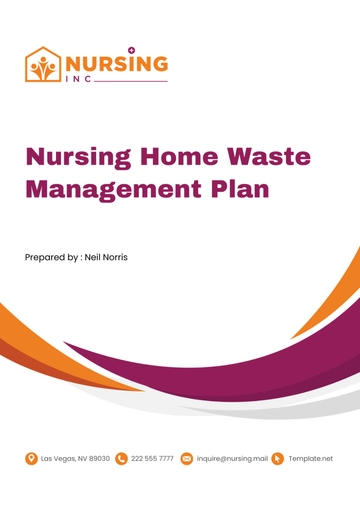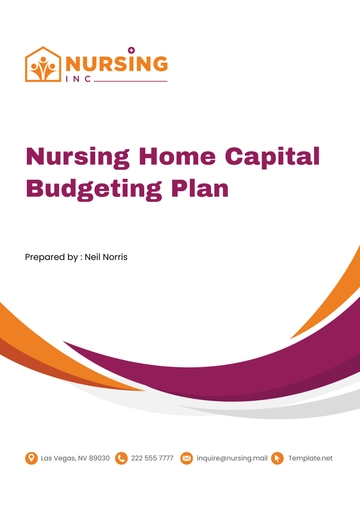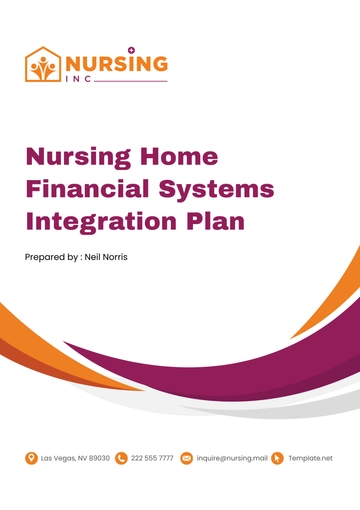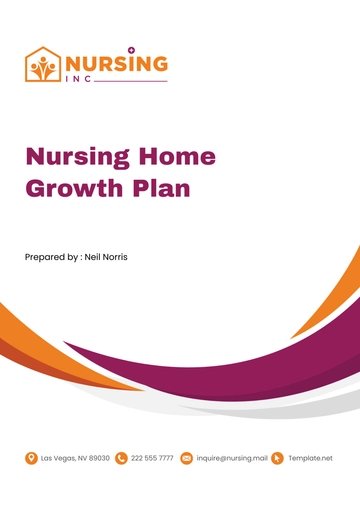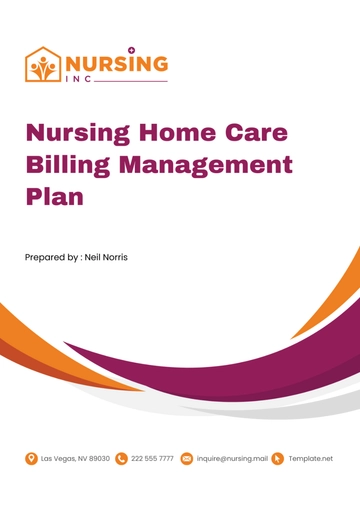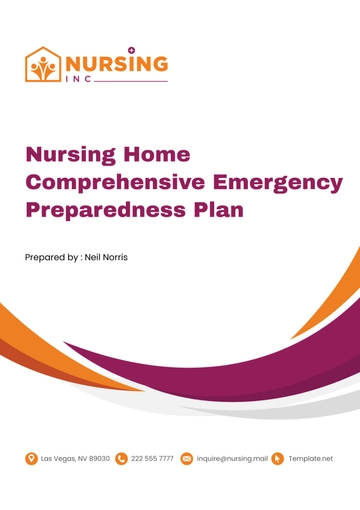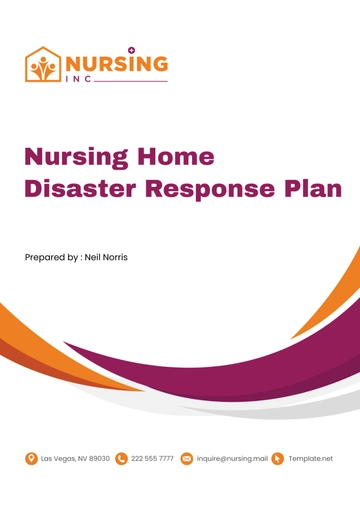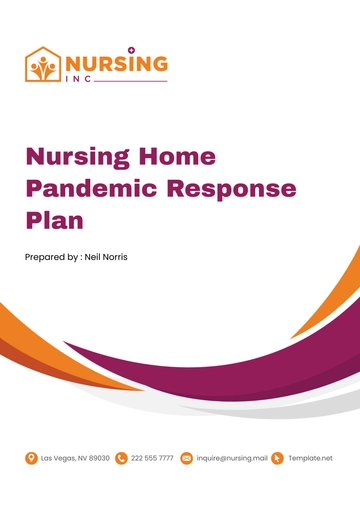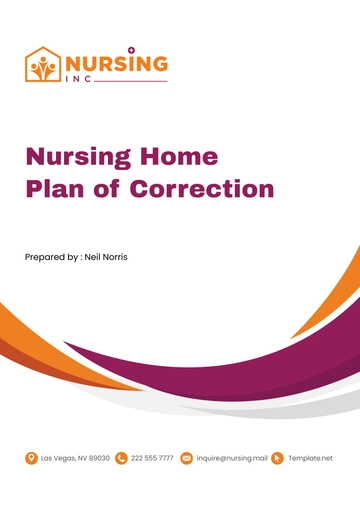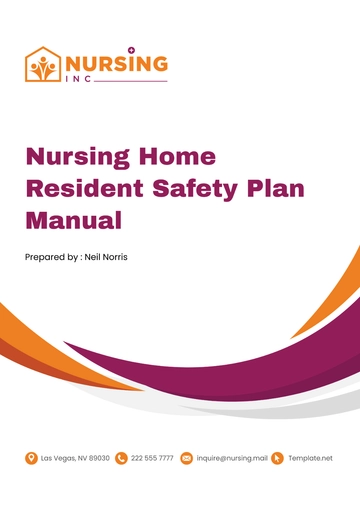Free Nursing Home Financial Systems Integration Plan
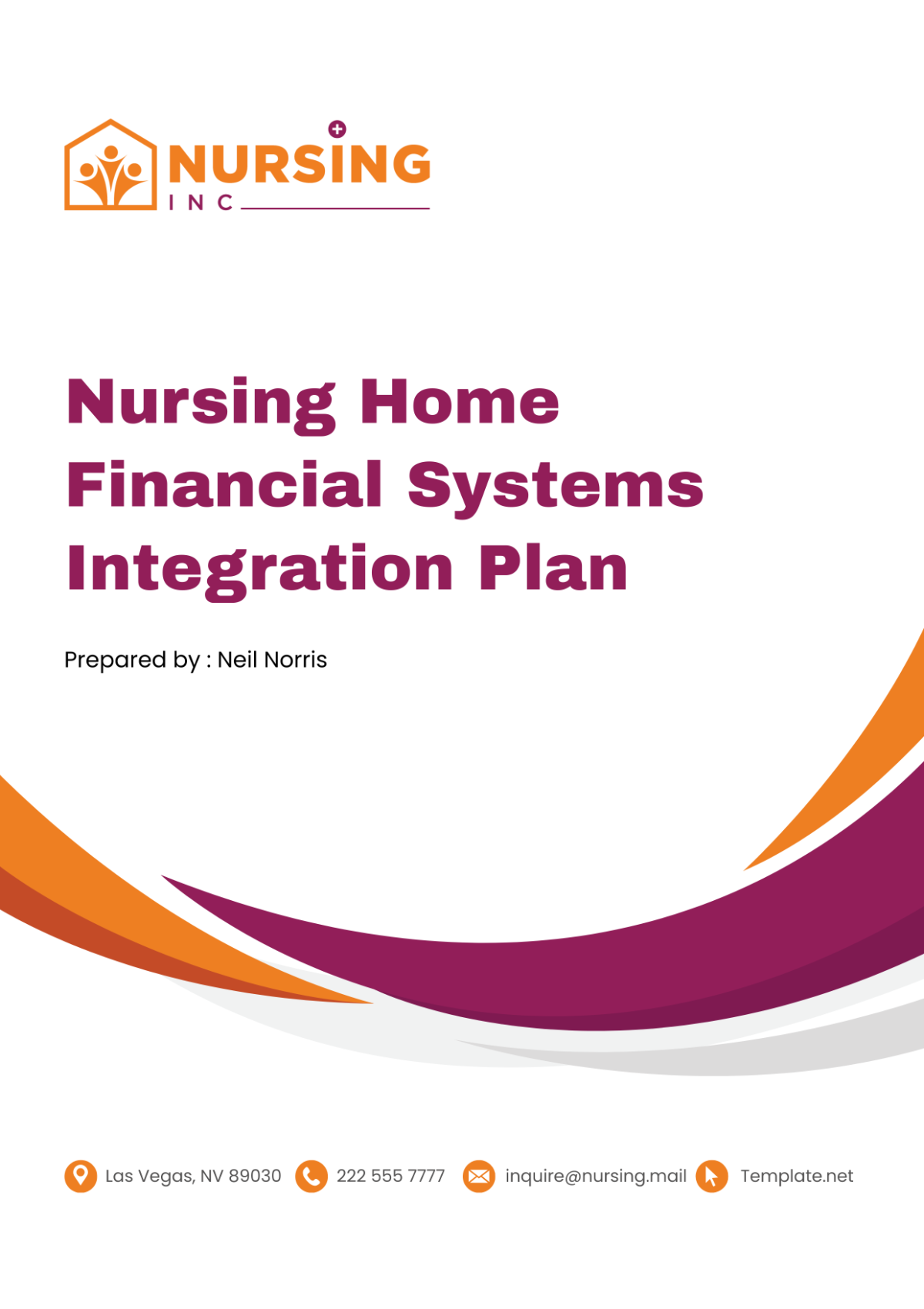
I. Executive Summary
A. Overview of the Integration Plan
The Financial Systems Integration Plan for [Your Company Name] outlines the strategic approach to consolidate various financial management processes and systems into a cohesive, efficient framework. This initiative is designed to streamline financial operations, enhance data accuracy, and improve financial reporting and decision-making capabilities across all departments of our nursing home operations.
B. Objectives and Goals
Streamline Financial Operations: To reduce redundancy and improve efficiency in financial management.
Enhance Data Accuracy: To ensure financial data integrity through centralized data management.
Improve Financial Reporting: To provide timely, accurate, and comprehensive financial reports to stakeholders.
Support Decision Making: To offer actionable financial insights for better strategic planning.
C. Brief Description of the Financial Systems to be Integrated
The integration plan will encompass the following financial systems:
Accounting and Bookkeeping: General ledger, accounts payable, and receivable.
Payroll Systems: Employee wages, benefits, and tax management.
Resident Billing and Payments: Invoicing, payment processing, and account management for residents.
Vendor and Supply Chain Finance Management: Procurement, vendor payments, and financial supply chain management.
Budgeting and Forecasting: Financial planning, analysis, and forecasting activities.
II. Background and Rationale
A. Current Financial Management Practices
At present, [Your Company Name] runs a variety of separate financial systems utilized for different functions such as accounting, payroll, and resident billing, among other business operations. These systems, unfortunately, function independently and do not communicate with each other. This mode of operation fosters an environment where data is stored in separate silos instead of a unified system, ultimately leading to inefficiencies in the overall process. Additionally, the risk of errors occurring increases due to the lack of integration amongst these disparate financial systems.
B. Challenges and Limitations of Existing Systems
Data Silos: Lack of real-time data sharing across departments.
Inefficiency: Repetitive data entry and reconciliation tasks.
Increased Error Risk: Manual data transfers and entries increase the risk of inaccuracies.
Delayed Reporting: Slower financial closing and reporting processes.
C. Need for Integration
By integrating our financial systems, we will be capable of addressing the existing challenges and problems we are facing. The main way that this integration will address these challenges is by automating the data flow between various processes. In a similar vein, it will also enhance and improve our operational efficiency significantly. Another area that will benefit from this integration is the reduction of errors, mistakes, and discrepancies that clog up our current financial operations. Lastly, through the integration of our financial systems, we also expect to facilitate faster as well as much more accurate financial reporting which will enable us to maintain accurate financial records.
III. Scope of Integration
Systems to be Integrated | Description | Stakeholders Involved |
|---|---|---|
Accounting and Bookkeeping | General ledger, accounts payable/receivable | Finance Team, IT Department |
Payroll Systems | Management of wages, benefits, taxes | HR Department, Finance Team |
Resident Billing and Payments | Invoicing, and payment processing for residents | Administrative Staff, IT Team |
Vendor Management | Procurement, vendor payments | Supply Chain Team, Finance Team |
Budgeting and Forecasting | Financial planning and analysis | Finance Team, Executive Board |
IV. Integration Strategy
A. Selection of Integration Tools and Software
After conducting an exhaustive analysis of the market and engaging in extensive consultations with experts in the fields of Information Technology and Finance, we have arrived at a decision regarding our choice of integration software. Our selection, [Integration Software Name], stood out from the competition due to a number of standout features and benefits. Paramount among these was its compatibility with our pre-existing system infrastructure. Additionally, its scalability allows for flexibility and expansion to accommodate growth and change within our operation. Lastly, the security measures embedded within the software are robust and give us confidence in its use across our systems. Therefore, these factors contributed to [Integration Software Name] being the most appropriate choice for our organization after careful consideration and scrutiny.
B. Data Migration Plan
1. Data Cleaning and Preparation
A comprehensive audit of existing financial data will be conducted to identify and correct inconsistencies, duplicate entries, and inaccuracies.
2. Secure Data Transfer Protocols
Data will be transferred to the new integrated system using encrypted channels to ensure confidentiality and integrity.
C. System Compatibility and Interoperability
[Integration Software Name] supports seamless integration with our existing financial systems, ensuring smooth data flow and interoperability between different software platforms.
D. Phased Integration Approach
1. Pilot Testing with Selected Modules
Pilot testing will be initiated with the Accounting and Bookkeeping system to assess the integration process, make necessary adjustments, and train staff.
2. Full-scale Implementation
Following successful pilot testing, a full-scale implementation will be executed across all financial systems, monitored closely for performance and efficiency improvements.
V. Technical Architecture and Infrastructure
The design approach that will be taken towards the technical architecture and infrastructure for the integrated financial system will have a meticulous focus on ensuring: scalability, to make certain that the system can handle increasing amounts of work and can be made to expand as needed; security, to protect from any potential internal or external threats; and efficiency, so as to maximize productivity with minimal wasted costs or effort. In this way, the setup of the financial system will be thoughtfully geared towards these key aspects.
A. Hardware and Software Requirements
The following table outlines the preliminary hardware and software requirements for the integration. These requirements are subject to refinement based on the detailed system selection and architecture design process.
Requirement Type | Description | Estimated Quantity | Notes |
|---|---|---|---|
Servers | High-capacity servers for database, application, and web services | 3 | Includes 1 backup server |
Workstations | High-performance computers for system administrators and finance staff | 15 | Upgrade existing workstations where possible |
Networking Equipment | Switches, routers, and firewalls to ensure robust and secure network infrastructure | Varies | To be determined by network audit |
Software Licenses | Integration platform, financial management software, and utility tools | Per user | Licenses for 50 users |
B. Network and Security Infrastructure
Security is paramount, especially when dealing with financial and personal data. The network infrastructure will be designed to prioritize data security and system reliability.
Data Encryption: All data in transit and at rest will be encrypted using industry-standard protocols.
Access Controls: Role-based access controls (RBAC) will be implemented to ensure users have access only to the data and functions necessary for their role.
Firewalls and Intrusion Detection Systems (IDS): To protect against external threats and monitor for suspicious activity.
C. Backup and Disaster Recovery Plans
A comprehensive plan that is specifically designed for backup and disaster recovery provides a guarantee that financial data, which is a vital asset of any organization, is duly protected against any potential loss or corruption. Safeguarding financial data this way ensures that it remains intact and is not susceptible to unfortunate circumstances that may compromise it, thus maintaining the financial stability and sustainability of the organization.
Daily Backups: Automated daily backups of all financial data, with backups stored both onsite and offsite.
Disaster Recovery Site: Establishment of a disaster recovery site to ensure rapid restoration of financial systems in case of a major incident.
Regular Testing: Quarterly testing of backup and disaster recovery procedures to ensure effectiveness.
VI. Training and Support
A. Training Programs for Staff
To ensure that the transition is smooth and that the new integrated financial system is used effectively, we will develop and implement comprehensive training programs. These programs will be specifically designed to aid in understanding and navigating the new system efficiently, thus minimizing errors and enhancing productivity.
Audience | Training Focus | Methodology | Duration |
|---|---|---|---|
IT Staff | System administration, troubleshooting | In-person, hands-on workshops | 2 weeks |
Finance Team | System functionality, data entry, reporting | Online modules, live sessions | 1 week |
Administrative Staff | Billing and payment processing, system navigation | Webinars, Q&A sessions | 1 week |
B. Ongoing Support and Maintenance Plans
In order to ensure that the system performs optimally post-implementation and to offer the necessary support to the staff, it is absolutely essential to have a plan in place for continued support and maintenance.
Service | Description | Availability |
|---|---|---|
Helpdesk Support | Issue reporting and resolution, user queries | 24/7 Phone and Email |
System Updates | Regular updates for system improvements | Quarterly |
Technical Maintenance | Hardware and software maintenance | As needed |
C. User Manuals and Documentation
We will be providing comprehensive user manuals and extensive system documentation. These resources will encompass a wide range of topics including system functionalities, troubleshooting guides, as well as frequently asked questions. It is our aim to provide you with a thorough reference library at your fingertips. To ensure easy access and to cater to the preferences of all users, these information-laden resources will be made available in two forms - tangible print copies to those who prefer a traditional format, and digital copies for users who prefer their reference materials to be accessible electronically.
VII. Budget and Financing
A comprehensive and detailed budget will be meticulously prepared. This budget will be designed to exclusively cover every facet of the costs associated with the integration of the system. Such costs include but are not limited to, the acquisition of necessary software, potential upgrades to existing hardware, provision of adequate training for personnel to handle the new system, and provision of ongoing support post-integration in order to efficiently handle any potential problems or issues that might arise.
A. Cost Estimation for Integration
Item | Estimated Cost | Notes |
|---|---|---|
Software Licenses | $25,000 | Cost for [Integration Software] including initial licensing fees for a comprehensive financial management system. |
Hardware Upgrades | $15,000 | Servers, network equipment, and necessary hardware upgrades to support the new software. |
Training | $10,000 | Includes materials and facilitators for comprehensive staff training on the new system. |
Support and Maintenance (Yearly) | $5,000 | Annual contracts with vendors for ongoing support, updates, and maintenance services. |
B. Financing Options and Resources
Internal Funding: Allocation from the annual IT budget.
External Financing: Exploring loans or grants suitable for healthcare technology advancements.
Vendor Financing: Negotiating payment plans with software and hardware vendors.
C. Return on Investment Analysis
Performing an analysis of the Return on Investment (ROI) will effectively showcase the various financial advantages that can potentially be reaped from integrating the system. The mentioned benefits span a range of areas such as cost savings, owing to a significant increase in efficiency levels, a reduction in the occurrence of errors, and an enhancement in the capabilities of handling and managing financial tasks and responsibilities. Each of these aspects contributes to building an economically healthier and more streamlined organization, ultimately proving the worth of the system integration.
VIII. Risk Management
A. Identification of Potential Risks
Risk Category | Potential Risks | Likelihood | Impact |
|---|---|---|---|
Technical | System incompatibilities, data migration issues | Medium | High |
Operational | Disruption to financial operations during the transition | High | Medium |
Financial | Exceeding budget, delayed ROI | Low | High |
B. Mitigation Strategies
Technical: Engage expert consultants for system compatibility and data migration.
Operational: Implement a phased integration approach with thorough testing.
Financial: Maintain a contingency fund, and regularly review budget and expenditures.
C. Contingency Plans
The development of contingency plans is essential for managing critical risk factors. These plans should include various strategies such as alternative methods for data migration. Along with this, temporary procedures for manual processing should also be a part of these contingency plans. Additionally, options for emergency funding should also be included to manage any unforeseen circumstances that might require immediate financial support.
IX. Evaluation and Monitoring
A. Key Performance Indicators (KPIs)
KPI | Target |
|---|---|
System Downtime | Less than 0.5% monthly |
User Satisfaction Scores | Above 85% |
Report Generation Time | Reduced by 50% compared to current |
Financial Data Accuracy | 99.5% accuracy rate |
B. Regular System Audits
Audits will be carried out every three months to evaluate the performance of the system, verify the precision of the data, and to determine if the system is in agreement with financial regulations.
C. Feedback Mechanism for Continuous Improvement
Establishing channels for staff to provide feedback on system usage, challenges, and suggestions for improvements. Regular review meetings will be scheduled to discuss feedback and plan enhancements.
X. Legal and Compliance Considerations
Ensuring compliance with legal and regulatory requirements is critical for the success of the financial systems integration project. This section outlines the approach to managing these considerations.
A. Data Protection and Privacy Laws
[Your Company Name] commits to stringent compliance with all applicable data protection and privacy laws, including but not limited to the Health Insurance Portability and Accountability Act (HIPAA) for health-related information and the General Data Protection Regulation (GDPR) for data concerning EU residents.
Data Protection Impact Assessment (DPIA): Conduct DPIAs before the integration to identify and mitigate data protection risks.
Data Processing Agreements (DPAs): Enter into DPAs with all vendors who will process personal data on behalf of [Your Company Name].
B. Financial Regulations and Standards Compliance
Compliance with Generally Accepted Accounting Principles (GAAP) and other relevant financial regulations is non-negotiable.
Regular Compliance Audits: Schedule annual audits to ensure ongoing compliance with all financial reporting and transaction regulations.
Compliance Training for Staff: Implement a regular compliance training program for all staff involved in financial operations.
C. Contracts and Agreements with Vendors
All contracts and agreements with vendors will include detailed provisions related to data security, system availability, compliance with laws and regulations, and audit rights.
Security and Compliance Clauses: Specific clauses mandating adherence to security standards and regulatory compliance.
Audit Rights: Include the right for [Your Company Name] to perform security and compliance audits on the vendor's systems and processes.
XI. Timeline and Milestones
A detailed project timeline will be developed, outlining key phases and milestones for the integration process.
Phase | Milestone | Deadline |
|---|---|---|
Planning and Preparation | Complete system selection and procurement | Month 1-3 |
Data Migration and Testing | Begin pilot testing with the Accounting System | Month 4-6 |
Training and Deployment | Start full-scale implementation and staff training | Month 7-9 |
Evaluation and Optimization | Conduct the first evaluation and make necessary adjustments | Month 10-12 |
XII. Conclusion and Next Steps
The Financial Systems Integration Plan sets a clear and strategic pathway for [Your Company Name] to revolutionize its financial operations. By integrating our disparate financial systems, we aim to enhance efficiency, improve accuracy, and foster better decision-making across the organization. The next steps toward realizing this vision include:
Vendor Finalization: Completing the selection process for software and hardware vendors based on detailed evaluations and negotiations.
Financing Arrangements: Securing the necessary funding for the project through budget allocations, financing, or other means.
Detailed Project Planning: Develop a detailed project plan, including a refined budget, project team assignments, and a more precise timeline.
Stakeholder Engagement: Engaging with all stakeholders to ensure buy-in and to facilitate a smooth transition to the new integrated system.
Implementation Kick-off: Officially launching the project according to the developed plan, beginning with the planning and preparation phase.
Through meticulous planning, execution, and ongoing management, [Your Company Name] will establish a robust financial management infrastructure that supports our mission of delivering exceptional care to our residents while ensuring financial sustainability and compliance.
- 100% Customizable, free editor
- Access 1 Million+ Templates, photo’s & graphics
- Download or share as a template
- Click and replace photos, graphics, text, backgrounds
- Resize, crop, AI write & more
- Access advanced editor
Streamline operations with Template.net's Nursing Home Financial Systems Integration Plan Template. Designed for seamless financial process integration, this template is fully customizable and editable via our Ai Editor Tool. Enhance efficiency, accuracy, and decision-making with a cohesive financial system. An essential tool for modernizing and optimizing financial management, exclusively available at Template.net.
You may also like
- Finance Plan
- Construction Plan
- Sales Plan
- Development Plan
- Career Plan
- Budget Plan
- HR Plan
- Education Plan
- Transition Plan
- Work Plan
- Training Plan
- Communication Plan
- Operation Plan
- Health And Safety Plan
- Strategy Plan
- Professional Development Plan
- Advertising Plan
- Risk Management Plan
- Restaurant Plan
- School Plan
- Nursing Home Patient Care Plan
- Nursing Care Plan
- Plan Event
- Startup Plan
- Social Media Plan
- Staffing Plan
- Annual Plan
- Content Plan
- Payment Plan
- Implementation Plan
- Hotel Plan
- Workout Plan
- Accounting Plan
- Campaign Plan
- Essay Plan
- 30 60 90 Day Plan
- Research Plan
- Recruitment Plan
- 90 Day Plan
- Quarterly Plan
- Emergency Plan
- 5 Year Plan
- Gym Plan
- Personal Plan
- IT and Software Plan
- Treatment Plan
- Real Estate Plan
- Law Firm Plan
- Healthcare Plan
- Improvement Plan
- Media Plan
- 5 Year Business Plan
- Learning Plan
- Marketing Campaign Plan
- Travel Agency Plan
- Cleaning Services Plan
- Interior Design Plan
- Performance Plan
- PR Plan
- Birth Plan
- Life Plan
- SEO Plan
- Disaster Recovery Plan
- Continuity Plan
- Launch Plan
- Legal Plan
- Behavior Plan
- Performance Improvement Plan
- Salon Plan
- Security Plan
- Security Management Plan
- Employee Development Plan
- Quality Plan
- Service Improvement Plan
- Growth Plan
- Incident Response Plan
- Basketball Plan
- Emergency Action Plan
- Product Launch Plan
- Spa Plan
- Employee Training Plan
- Data Analysis Plan
- Employee Action Plan
- Territory Plan
- Audit Plan
- Classroom Plan
- Activity Plan
- Parenting Plan
- Care Plan
- Project Execution Plan
- Exercise Plan
- Internship Plan
- Software Development Plan
- Continuous Improvement Plan
- Leave Plan
- 90 Day Sales Plan
- Advertising Agency Plan
- Employee Transition Plan
- Smart Action Plan
- Workplace Safety Plan
- Behavior Change Plan
- Contingency Plan
- Continuity of Operations Plan
- Health Plan
- Quality Control Plan
- Self Plan
- Sports Development Plan
- Change Management Plan
- Ecommerce Plan
- Personal Financial Plan
- Process Improvement Plan
- 30-60-90 Day Sales Plan
- Crisis Management Plan
- Engagement Plan
- Execution Plan
- Pandemic Plan
- Quality Assurance Plan
- Service Continuity Plan
- Agile Project Plan
- Fundraising Plan
- Job Transition Plan
- Asset Maintenance Plan
- Maintenance Plan
- Software Test Plan
- Staff Training and Development Plan
- 3 Year Plan
- Brand Activation Plan
- Release Plan
- Resource Plan
- Risk Mitigation Plan
- Teacher Plan
- 30 60 90 Day Plan for New Manager
- Food Safety Plan
- Food Truck Plan
- Hiring Plan
- Quality Management Plan
- Wellness Plan
- Behavior Intervention Plan
- Bonus Plan
- Investment Plan
- Maternity Leave Plan
- Pandemic Response Plan
- Succession Planning
- Coaching Plan
- Configuration Management Plan
- Remote Work Plan
- Self Care Plan
- Teaching Plan
- 100-Day Plan
- HACCP Plan
- Student Plan
- Sustainability Plan
- 30 60 90 Day Plan for Interview
- Access Plan
- Site Specific Safety Plan
